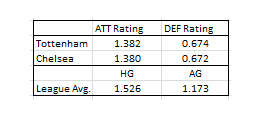How to Create a Basic Football Model

In the last decade or so the idea of using a model to price up football matches has gained major traction and it now seems that everybody from bookmakers to syndicates to professional bettors are using them. Hopefully the following explanation will give you a better understanding of the initial process behind the creation of a simple goals model.
The example we will look at is a goals only pre-match pricing model for the 2018/19 English Premier League.
1) Attack & Defence ratings.
The first stage in our modelling process is to quantify how effective each Premier League side is in both phases of the game. We do this by forming an attack (ATT) and a defence (DEF) rating for each of them. These are calculated by taking the average goals scored or conceded for the chosen sample size (one and a half seasons is our chosen sample). These averages are then divided by the league average.
For example, over their last 57 Premier League games played, Tottenham have scored an average of 1.872 goals per game (PG). The league average goals scored PG is 1.355. This leads to an ATT Rating of 1.382 (1.872/1.355).
The DEF rating is calculated in a very similar way, but this time you are looking at the average goals conceded per game over the given sample size. Therefore, as Tottenham have conceded an average of 0.913 goals PG and the league average is 1.355, their DEF Rating is 0.674 (0.913/1.355).
2) Home & Away goal expectancies.
Goal expectancies are formed by taking into account the attacking and defensive capabilities of each team (using the above ratings) in conjunction with home & away league goal averages.
For example, let’s look at a Premier League match with Tottenham as the home side and Chelsea as the away side.

The attack and defence ratings for both sides are very similar and if this match was to be played at a neutral venue, you would expect the prices to be almost identical. This is why it is important to account for home advantage and this is done using the league average home and away goals.
To calculate home goal expectancy, Tottenham’s ATT rating is multiplied by Chelsea’s DEF rating then multiplied again by the league average home goals. Therefore: 1.382 * 0.674 * 1.526 = 1.42.
Away Goal Expectancy is the same calculation but flipped over with Chelsea’s ATT rating multiplied by Tottenham’s DEF rating and the league away goal average. This gives them an Exp AG figure of 1.09.
3) Pricing up markets.
Now we have the HG Exp and the AG Exp we can form the Supremacy and Total Goals quotas for the match in question.
Supremacy (Sup) refers to HG Exp – AG Exp (1.42 - 1.09) whilst Total Goals (TG) is the sum total of the two (1.42 + 1.09).

At this point you can compare your supremacy figures against market prices and your total goals quota against the over/under goal prices available to help you come to a decision regarding your potential bets. This shows how an easily created football model can help with your betting.
If you wish to take the pricing process to the next step please read on.
To then convert these Sup and TG quotas into decimal prices we need to introduce a mathematical concept called Poisson distribution.
Poisson distribution refers to the idea of measuring the probability of independent events happening a certain number of times within a set period, such as the number of goals scored in a football match. In simple terms, it can be used to convert averages into probabilities.
For example, if we know that a football team averages 1.5 goals per game, the Poisson distribution formula tells us that this average equates to the team in question scoring 0 goals 22% of the time, 1 goal 34% of the time, 2 goals 25% of the time, 3 goals 13% of the time and so on.
If we look again at our match in focus, we know that the average Exp HG for Tottenham is 1.42 and the avg. Exp AG for Chelsea is 1.09. Using this data we can create the following probability table using the Poisson function in MS Excel.

As can be seen above, the chance of the home team (Tottenham) scoring two goals is 24.4%. The chance of the away team (Chelsea) scoring one goal is 36.6%. These probabilities can then be multiplied together resulting in an 8.93% chance of the match finishing 2-1 to Tottenham.
We can apply the same method across all possible score lines and subsequently create a correct score table:

Now the pricing process can be completed.
The above table shows the chance of each score line occurring. We can turn these into decimal prices by dividing the percentage into 1. As discussed above, the chance of the correct score 2-1 Tottenham is 8.93% (or 0.0893). The calculation required is therefore: 1/0.0893 = a decimal price of 11.2.
Using the same method we can price up any number of markets. All we need to do is find the total sum of the chances of relevant score lines. For example, if we wish to price up the Draw in the Match Result market, we simply add together the chances of 0-0, 1-1, 2-2, 3-3 and 4-4 in the above table. This equates to (8.13% + 12.58% + 4.87% + 0.84% + 0.08%) = 26.5%. Then if dividing the percentage into 1, we eventually come to a price of 3.77 (1/0.265).
In a Similar way to this, if you wish to price up under 2.5 goals in the Total Goal markets, simply bring together all the score lines which would support this eventuality (0-0, 1-1, 1-0 either way, 2-0 either way). Or if you want to go more left field and price up Chelsea to win and both teams to score, just take 1-2, 2-3, 1-3, 2-4 and 3-4.
Hopefully this gives you an insight into the potential value and effectiveness of football models as part of your betting decision making process.
Yes, you. We’re always looking for new authors. If you’ve got great articles/news that will be of interest to our readers and help to move our betting exchange forward, we would love to hear about them. Our aim is to bring readers a fresh perspective on all things betting. We want your article to be at its best. Once accepted, you’ll get extensive feedback from our team.